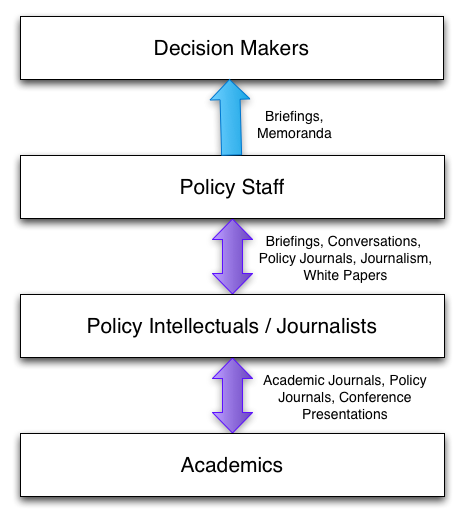In a recent post about policy blogging, I asked
So, health policy bloggers: If Reid, Boehner, and McConnell can’t sway public opinion, despite the audiences they command, what do you hope to accomplish?
I answered that
By developing new and powerful ways of helping people understand their situations, public intellectuals and politicians can prepare people to take effective action to improve those situations.
But I wanted to know how other bloggers would respond. Keith Humphreys answered that his blogging engages:
readers [who include] journalists, elected officials, Congressional and White House staffers, police officers, health care system managers, teachers, judges, economists, social workers, physicians, university administrators, business leaders, civil servants, policy analysts and many other people who regularly face up to the challenge of designing, analyzing and implementing public policy… Add up all the people who implement public policy, study it, or just know a lot about it, and you get a sadly small number, way too small to ever kid myself that my blogging could move mass opinion in a country of over 300 million people. But what it clearly can do is put good information and ideas into the hands of people who matter in and care about the public policy world.
I concur. I made a related point a couple of years ago in a blog conversation with Austin (his comment here, Kristen Rosengren’s here, further comments of mine here and here). Referring to this schematic…
…I commented:
Let’s simplify the world of health policy discourse to four strata of participants: decision makers, their policy staff, policy intellectuals and journalists, and academics. There is an insider culture grounded in a network of peer interaction within each stratum. The arrows are meant to suggest patterns of communication between strata, and examples of the media that support them.
Policy blogging speeds communication in the channels denoted by the double headed arrows. Through blogging, academics and policy intellectuals can write on the issues of the day for journalists and policy staff. The latter can use our words and thoughts to inform decision makers. This is absolutely worth doing.
Keith also wrote about the personal rewards of blogging.
[Blogging] can also provide me with an opportunity to learn from my readers and thereby come to a better understanding of the policy issues I care about. The public at large will likely never know (or care) about this ongoing exchange of wonky material within a small community. But I do, and that’s enough to keep me going.
Just so. I wrote a while back.
Scientific blogging can enable you to find the invisible college of people who care about an intersection of disciplines that you care about, and you may have believed that you were the only one who cared about.
As Keith suggests, we write for a larger audience than just the policy elite. Here is an extraordinary visualization of the larger invisible college of scientific collaboration.

It’s extraordinary in part because it shows so clearly who is not in the community.
Policy blogging should transport information back and forth across the membrane encapsulating the scientific community. We are not ‘dumbing down’ our disciplines, but rather acknowledging that over and above the barrier of technical detail, science strips a fact from its lived context. To make science accessible, we need to return facts to a lived context by writing imaginatively so that a fact
awakens and enlarges the mind itself by rendering it the receptacle of a thousand unapprehended combinations of thought.
So that’s my defense of blogging. I hope to be read not as a partisan of secular liberalism, though I am, but as someone aspiring to be a good science writer.


